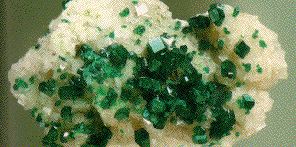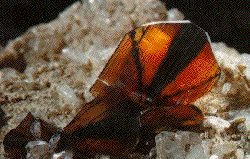
Using a Mineral Database for Classification
Students' Page
Copyright 1999 by James
P. Riser
Background info:
A database stores information in categories called fields.
Each of these fields can be utilized as an element in a search
of the entire database. If a database is set up properly, it can
be used for mineral identification. In this activity, a database
will be created and then used to attempt to classify several minerals.
One of the purposes of this activity is to give you practice
using a database for a meaningful task - not to teach you how
to set up the database. Consult the manual for this.
Software:
A generic program like ClarisWorks or Microsoft Works will
do the job quite well. These programs often come bundled with
a new computer.
Procedure:
Using the database portion of the program, create a new database
with these fields:
- Name
- Color
- Luster
- Acid test
- Streak
- Fracture/Cleavage
- Hardness
- Magnetism
- Crystal
- Specific Gravity
- Fluorescent
- Phosphorescent
- Double Refraction
Into each of these fields must be input information for every
mineral that will be identified. Be certain to spell everything
correctly! In nature, this would be thousands of minerals. For
practical uses in this activity, a much smaller range of information
may be used. Your instructor will have selected and obtained a
group of minerals to be identified.
In addition, your instructor will provide you with a list of
these minerals by name.
Your task will be to locate information on each of these minerals
and input the necessary information into your database. Your source
of information can be science textbooks, the internet, CD-ROMs,
mineral books, and anything else available in your local library.
Once you have located the information and put it into your
database, you are ready to attempt to use this database to identify
the minerals selected by your instructor.
Termonology:
In order to identify the minerals, you will need to understand
the termonology being used for the various mineral tests. Each
item (field name in your database) will be briefly explained.
- Name, of course, refers to what a mineral is called.
Some minerals have more than one common name. These names might
vary depending upon the location where the mineral was found.
- Color is referring to the appearance of the mineral
by just looking at it. Some mineral may have a wide range of
colors. Color is not the best criteria for identification.
- Luster refers to the way light is reflected from the
surface. Luster will usually be described in terms such as -
metallic, waxy, glassy, or pearly.
- Acid test refers to whether the mineral fizzes or
reacts when a drop of diluted acid is placed on it.
- Streak is the color of the mark left by a mineral
as it is rubbed on a piece of unglazed tile. The streak may be
a different color than the mineral. Some minerals will not leave
a streak. The streak is actually a powered sample of the mineral.
- Fracture/Cleavage refer to the way that a mineral
breaks. Fracture might be crumbly or glasslike (conchoidal).
Cleavage is smooth fractures in flat planes and will be expressed
as a number - indicating how many planes the mineral fractures
along. Fibrous or splintery are other fracture options.
- Hardness will be expressed as a number derived from
the Moh's Hardness Scale. How to determine the number when testing
your minerals is explained in most books on minerals.
- Magnetism refers to whether the mineral is attracted
by a magnet. Some samples might themselves be magnetic.
- Crystal refers to the shape of the crystals that make
up the mineral.
- Specific Gravity equals the mass of the mineral sample
in the air divided by the mass of an equal volume of water. This
will be expressed as a number.
- Fluorescent refers as to whether a mineral glows under
ultraviolet light.
- Phosphorescent minerals will continue to glow after
the ultraviolet light is turned off.
- Double Refraction refers to a situation in which the
mineral splits light passing through it into two paths. This
causes two images to be seen when looking through the mineral.
Getting started:
It is now time to collect mineral information and to build
your mineral database.